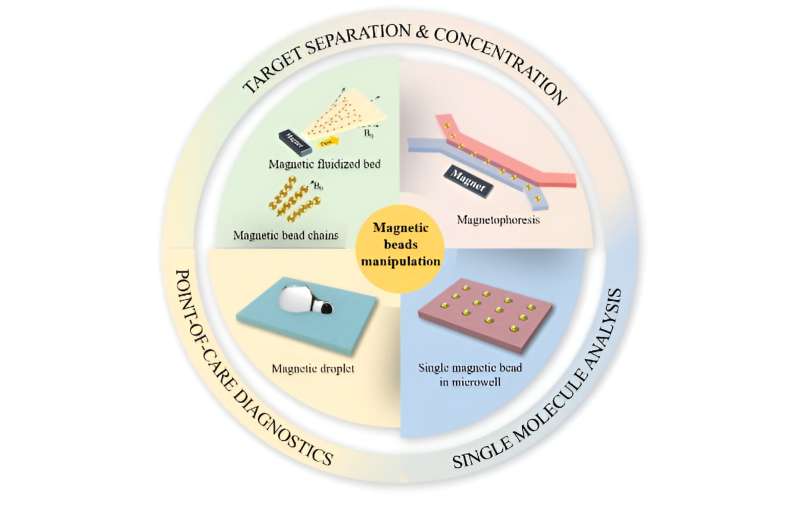This article has been reviewed according to Science X's editorial process and policies. Editors have highlighted the following attributes while ensuring the content's credibility:
fact-checked
peer-reviewed publication
proofread
Magnetic bead manipulation in microfluidic chips for biological application

In recent years, microfluidics has emerged as a revolutionary technology for biological analysis and medical diagnostics, enabling the precise control and manipulation of fluids at the microscale. At the same time, functionalized magnetic beads have become an indispensable tool for the selective capture and enrichment of target analytes.
The integration of microfluidics and magnetic beads can reap synergistic benefits for enhancing assay performance. However, realizing this potential requires innovative techniques to actively control magnetic beads within microfluidic devices.
Facing the development of current magnetic control technology, Professors Jianlong Zhao and Shilun Feng's team from Shanghai Institute of Microsystem and Information Technology, Chinese Academy of Sciences has made a detailed categorization and introduction on the mechanisms of magnetic bead manipulation in microfluidic chips. The paper, "Magnetic Beads Manipulation in Microfluidic Chips for Biological Application," was published in the journal Cyborg and Bionic Systems on April 14, 2023.
"The magnetic manipulation combining with microfluidics has garnered considerable attention due to there are several meeting points between two technologies such as large surface-to-volume ratio and controllability," the authors said. "In this review paper, we intend to present a thorough and in-depth overview of recently magnetic beads manipulation in microfluidic chip and its biological application."
The study authors have categorized magnetic bead manipulation techniques in microfluidics into five main types: magnetophoresis, magnetic bead chains, magnetic fluidized bed, magnetic droplets and magnetic bead in microwell.
These methods have different application advantages according to the movement states and detection purposes of magnetic beads. For example, magnetophoresis utilizes non-uniform magnetic fields for oriented motion, magnetic bead chains form chain-like structures for fixation or manipulation, magnetic fluidized beds achieve the fluidization of magnetic beads to improve target capture, magnetic droplets conduct biochemical operations on droplets containing magnetic beads, and microwell arrays immobilize single magnetic beads for single molecule detection.
"The main role of magnetic beads in these works was actually a carrier of biological recognition molecules for capturing specific biomarkers. Actually, magnetic bead can also be used as a signal output itself," the authors said. And some examples and the advantages using the magnetic bead directly as the signal output were provided in this review.
"Although the magnetic manipulation system has been greatly developed, it still has many remaining challenges when facing industrial and clinical applications," said Feng, pointing out that the current sample processing throughput of magneto-microfluidic chips is still low, which cannot meet the needs of large-scale clinical testing.
A fully automated closed-loop feedback magnetic manipulation platform is still urgently required as the current systems mainly rely on open-loop control algorithms and could only perform the magnetic control by a given set of pre-determined parameters.
The authors say that the size uniformity of the magnetic beads used in the microfluidic system is also a critical issue and developing innovative particle separation techniques to achieve accurate sorting of magnetic beads with a given size is important.
Authors of the paper include Gaozhe Cai, Zixin Yang, Yu-Cheng Chen, Yaru Huang, Lijuan Liang, Shilun Feng, Jianlong Zhao.
More information: Gaozhe Cai et al, Magnetic Bead Manipulation in Microfluidic Chips for Biological Application, Cyborg and Bionic Systems (2023). DOI: 10.34133/cbsystems.0023
Journal information: Cyborg and Bionic Systems
Provided by Beijing Institute of Technology Press Co., Ltd





















